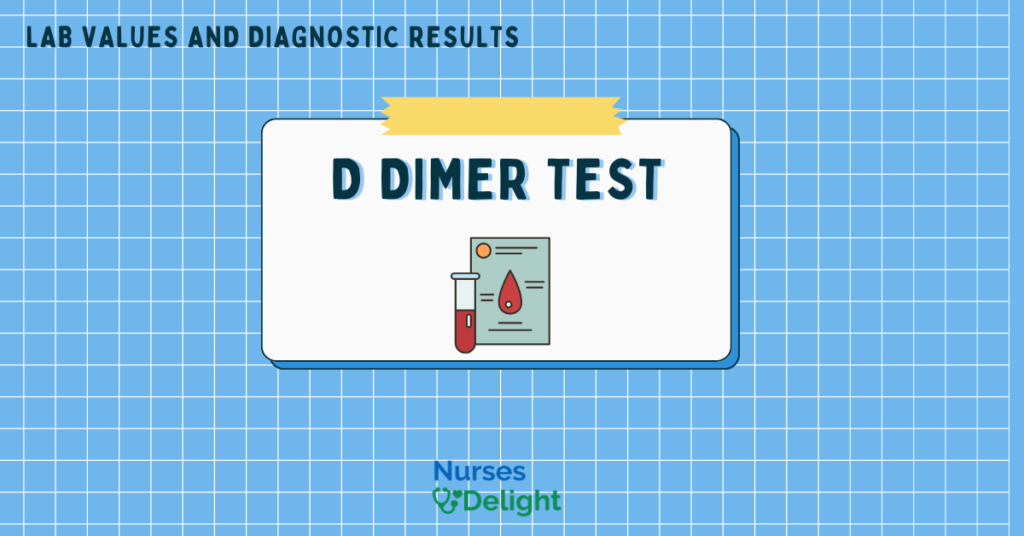D-dimer is the degradation product of crosslinked (by factor XIII) fibrin. The current activation of the hemostatic system is identified by this test. D-Dimer is a test done to measure formation and lysis of a clot that results from the fibrin degradation.
Normal Range
The findings will depend on the units used.
- Fibrinogen Equivalent Units (FEU) < 500 ng/mL
- D Dimer Units (DDU) < 250 ng/mL
Indications
The test is used to diagnose;
- Deep venous thrombosis
- Disseminated intravascular coagulation and helps in monitoring the effectiveness of its therapy.
- Pulmonary embolism
- Stroke
Interpretation
A low level of D-Dimer indicates no clotting disorder and high levels of d-Dimer indicates a probable clotting disorder. However, not all high reading of D-Dimer indicates a clotting disorder.
Increased Levels
- Blood Clotting Disorders
- Pulmonary Embolism
- Deep Vein Thrombosis,
- Pregnancy
- Recent Surgery.
Interfering Factors
- Pregnancy
- Cigarette smoking
- Trauma
- Infection
- Sepsis
- Elderly patients,
- Immobilized patients
- Autoimmune diseases can cause elevation of d-Dimer levels.
Nursing Implications
Pretest
- Obtain the patient’s medical history, including a list of all known allergens.
- Obtain the patient’s medical history regarding their immune system, hematopoietic system, history of bleeding problems, and the outcomes of any previous tests or procedures—in particular, the bleeding time, complete blood count, clotting time, partial thromboplastin time, prothrombin time, and platelets.
- Obtain a list of all the drugs the patient is taking, including acetylsalicylic acid, herbal remedies, nutraceuticals, anticoagulant therapy, and other drugs that are known to interfere with coagulation. It is advised to stop using it 14 days before to any dental or surgical operations.
- If the patient frequently utilizes the requested laboratory and/or health care provider, they should be informed.
- Make a note of any recent practices that might affect the outcome of the test.
- Unless directed by a doctor, there are no limitations on food, drink, or medication.
- Talk over the process with the patient.
- Tell the patient that it will take five to ten minutes to collect the specimen.
Intra-test
- Ask the patient to avoid moving needlessly and to breathe normally.
- Take the usual safety precautions and adhere to the blood collection guidelines.
- After venipuncture, discard the first mL of blood by collecting a discard tube.
- Collect the specimen in a blue-top (3.2% sodium citrate) tube.
- Once the specimen has been labeled, quickly submit it to the lab.
Post-test
- Check the venipuncture site for signs of hemorrhage or hematoma development. Put a pressure bandage on it.
- Tell the patient to report any bleeding from their mucous membranes or skin.
- Remind the patient who has a lowered platelet count of the significance of taking preventative measures against bleeding and bruising. These include using an electric razor, a soft toothbrush, avoiding constipation, avoiding acetylsalicylic acid and related products, and avoiding intramuscular injections.
- If the patient is taking an anticoagulant, remind them of the significance of routine laboratory testing.
- Analyze test findings in light of the patient’s symptoms and the outcomes of other tests. Bleeding time, clot retraction, total blood count, red blood cell morphology and inclusions, platelet antibodies, and white blood cell count are related laboratory examinations.
References
- Fischbach F., Dunning M. [2015] A manual of laboratory and diagnostic test. 9th Ed. Wolters Kluwer Health. Lippincott Williams & Wilkins.
- Schnell B et al. [2003] Davis’s Comprehensive Laboratory and Diagnostic Test Handbook—with Nursing Implications. F. A. Davis Company Philadelphia.
- Castellone, D. [1999] Coagulation the good, the bad and the unacceptable. Advance for Medical Laboratory Professionals.
- Cavanaugh, B. [ 1999] Nurses’ Manual of Laboratory and Diagnostic Tests, ed 3. FA Davis, Philadelphia.



